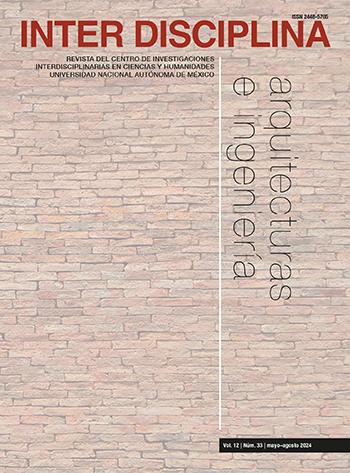Patrimonio arquitectónico industrial minero de Pachuca e identidad social. Modelo matemático hacia el proceder del fenómeno
Contenido principal del artículo
Resumen
En el análisis de fenómenos sociales como el presente caso de estudio, no siempre es fácil hacerlo a profundidad y, por lo tanto, aportar propuestas que contribuyan al mismo partiendo solo de bases teóricas. Recurrir a la disciplina de la estadística matemática es cada vez más necesario para comprender mejor los fenómenos sociales. La apropiación del patrimonio arquitectónico, se ha dicho, es necesaria para reforzar la identidad colectiva; pero, para saber cómo se logra o cuáles elementos o acciones sociales favorecen ese vínculo, se realizó un modelo matemático con base en los resultados de una encuesta, cuyos reactivos se relacionaron con la identificación de los elementos culturales de Pachuca, entre ellos y como variable respuesta, parte de su legado arquitectónico industrial minero. El objetivo fue detectar el vínculo social existente entre habitantes y patrimonio, y, al mismo tiempo, identificar las variables que más inciden en ello.
Descargas
Detalles del artículo
Citas en Dimensions Service
Citas
Belmar, I. B. 2014. Patrimonio como formador de identidad cultural y bienestar social: La pérdida de éste y sus consecuencias en Varsovia post segunda guerra mundial. Santiago de Chile: Pontificia Universidad Católica de Chile.
Caraballo Perichi, Ciro. 2010. La lista del patrimonio mundial y las instalaciones mineras. La reciente experiencia de Chile. En De Belem Oviedo Gámez, Miguel Iwadare Iijima y Marco Antonio Hernández Badillo (eds.), Patrimonio industrial minero. Nuevas alternativas para una gran historia. Pachuca: AHYMM A.C., 159-166.
Carrión, F. 2005. El centro histórico como proyecto y objeto de deseo. Eure, 89-100.
Change.org. 2020. Iniciativa de decreto de la poligonal que integra los talleres de Maestranza; Pachuca Hgo. Junio 17. https://www.change.org/p/gobernador-del-estado-de-hidalgo-iniciativa-de-decreto-de-la-poligonal-que-integra-los-talleres-de-maestranza-pachuca-hgo.
Chihu Amparán, A. y López Gallegos, A. 2007. La construcción de la identidad colectiva en Alberto Melucci. Polis, 125-159.
Díaz Fernández, Montserrat y Emilio Costa Reparaz. 1994. Metodología de la investigación econométrica. Documentos de trabajo de la Facultad de CC. Económicas y empresariales. Facultad de CC. Económicas y empresariales, Doc. O64/94, 2-32. Oviedo: Universidad de Oviedo, 1994.
Espinosa, Agustín y Guilliana Tapia. 2011. Identidad nacional como fuente subjetiva y social. Boletín de Psicología, 102 (julio): 71-87.
Gómez Campos, Yisel y Erly Arner Reyes. 2008. Caracterización gráfico-teórica de los hitos en el centro histórico de Santiago de Cuba. Ciencia en su PC, 80-88.
Hernández, Elizabeth. 2021. “Yo estoy rescatando La Maestranza”, dice secretario de Turismo de Hidalgo. Milenio, 12 de junio. https://www.milenio.com/politica/comunidad/pachuca-yo-estoy-rescatando-la-maestranza-eduardo-banos.
Hernández Ramírez, Macarena y Esteban Ruíz-Ballesteros. 2016. Consumo patrimonial: entre el mercado y la cultura. Chungara, 49(1).
ICOMOS (Comité científico Internacional de Turismo Cultural). 1999. Carta Internacional sobre Turismo Cultural. México: ICOMOS.
Mercado, Maldonado y Alejandrina V. Hernández Oliva. 2010. El proceso de construcción de la identidad colectiva. Convergencia, 53 (mayo-agosto): 229-251.
Prats, L. 2005. Concepto y gestión del patrimonio local. Cuadernos de Antropología Social, 17-35.
Quiroz Rothe, Héctor. 2006. Urbanismo reciente y nuevas identidades en México. Historia Actual Online, 9: 53-61.
Rivera Blanco y Salvador Pérez Arroyo. 2000. Carta de Cracovia. Cracovia.
Sobrino, Julián. 2018. Carta de Sevilla. Sevilla: Centro de Estudios Andaluces.
Tamayo, Sergio y Kathrin Wildner. 2005. Espacios e identidades. En Sergio Tamayo y Kathrin Wildner (eds.), Identidades urbanas. Ciudad de México: Universidad Autónoma Metropolitana, 11-36.
Thierauf, Robert J. 1982. Toma de decisiones por medio de investigación de operaciones. México: Limusa.
UNESCO. 1964. Carta de Venecia. Venecia, 1964.
Wildner, Kathrin. 2005. Espacio, lugar e identidad. Apuntes para una etnografía del espacio urbano. En Sergio Tamayo y Kathrin Wildner (eds.), Identidades urbanas. México: UAM, 201-227.

Esta obra está bajo una Licencia Creative Commons Atribución-NoComercial-SinDerivar 4.0 Internacional.





